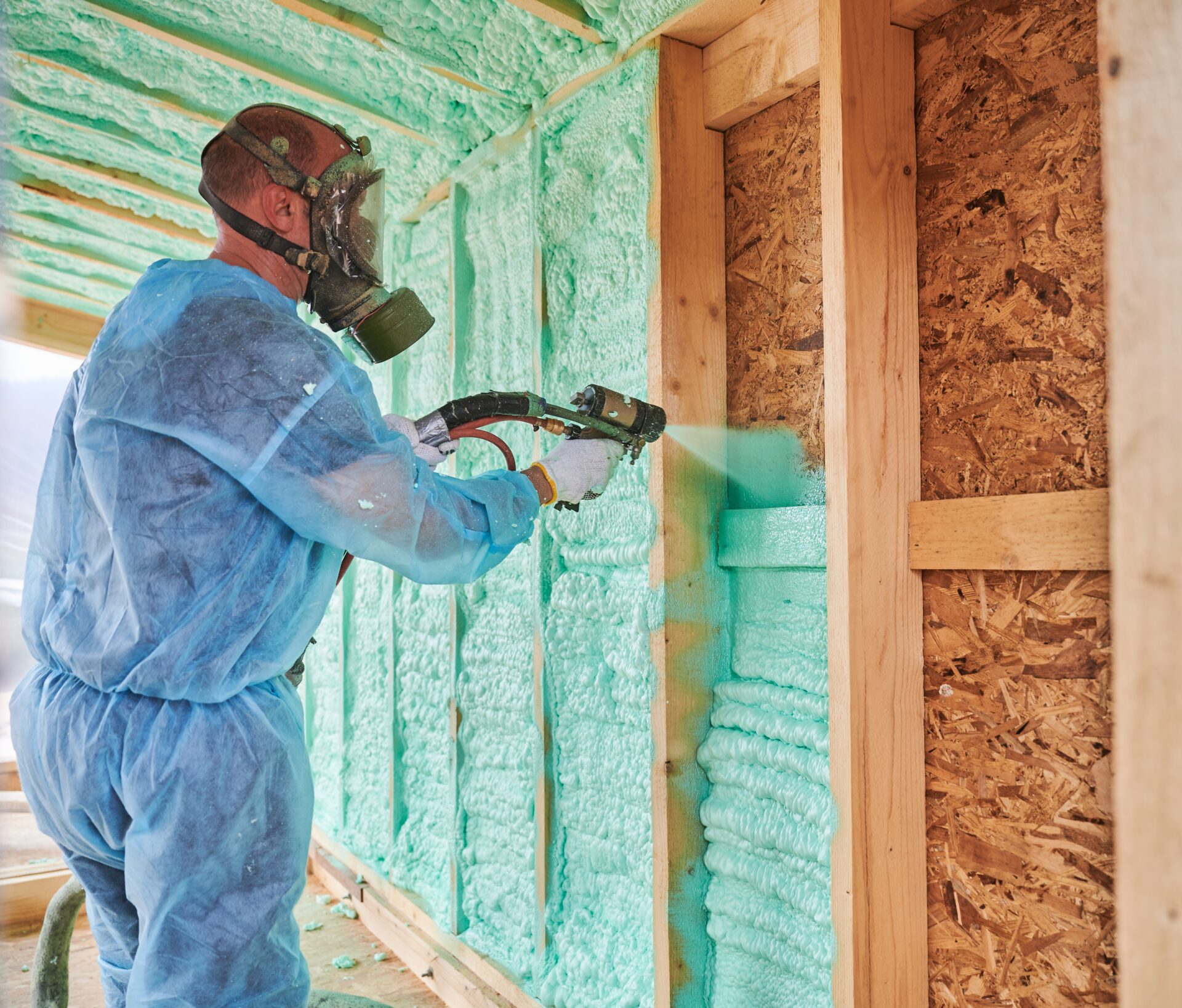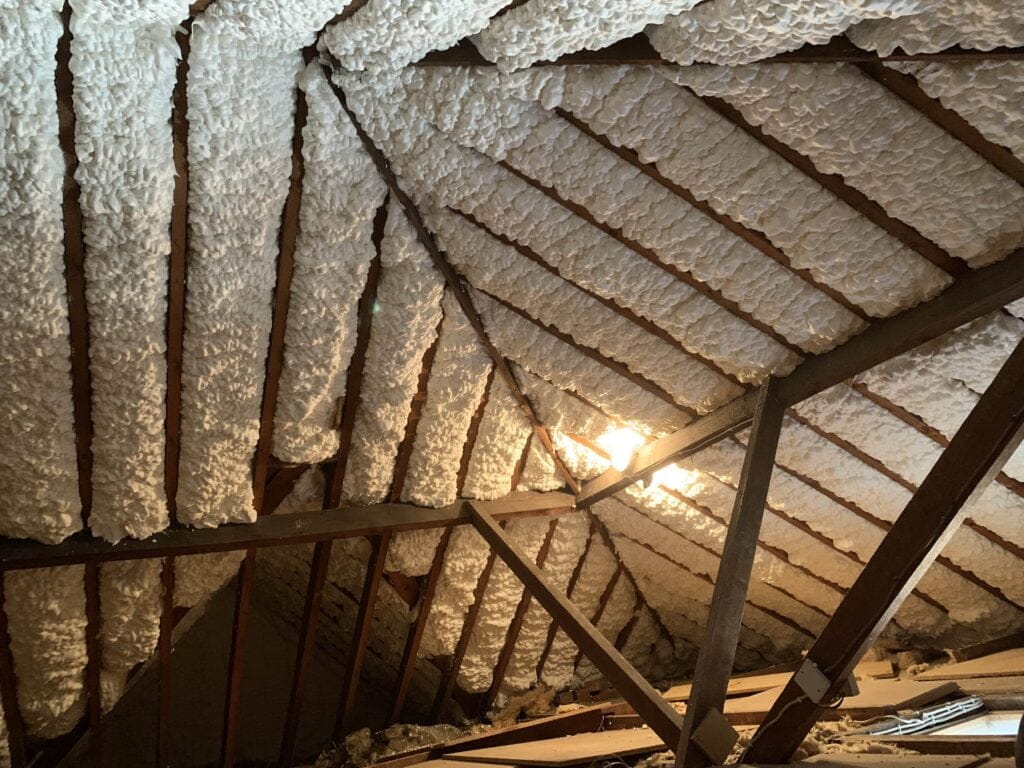Common Misconceptions Regarding Spray Foam: Debunking the Misconceptions
Common Misconceptions Regarding Spray Foam: Debunking the Misconceptions
Blog Article
Spray Foam: The Ultimate Option for Air Sealing and Insulation
Spray foam insulation has actually become a leading solution for efficient air securing and thermal insulation, offering an one-of-a-kind combination of residential or commercial properties that set it aside from conventional techniques. Its capacity to increase and fill up voids makes it particularly reliable in preventing air leakage, which can dramatically affect power effectiveness. Recognizing the full scope of its benefits, installation processes, and contrasts with other insulation types is crucial for making informed decisions. As we check out these elements, the effects for both new buildings and retrofits come to be increasingly significant. What elements should affect your option?
What Is Spray Foam?
Spray foam is a versatile insulation material that incorporates the principles of air securing and thermal resistance to boost energy efficiency in structures. Composed mainly of polyurethane or other comparable substances, spray foam is applied as a fluid that increases upon call with surfaces, producing a solid, constant layer of insulation. This one-of-a-kind residential property allows it to load voids, splits, and voids that traditional insulation materials may forget, supplying a premium air seal.
There are two major sorts of spray foam: open-cell and closed-cell. Open-cell spray foam is lighter and a lot more adaptable, using superb sound absorption and a reduced R-value per inch - Spray Foam. On the other hand, closed-cell spray foam is denser, offering a higher R-value, wetness resistance, and included structural stability to constructing parts
The application procedure typically entails specific tools, making sure a seamless application that follows different substrates, including concrete, metal, and wood. This flexibility makes spray foam ideal for both new buildings and retrofitting existing frameworks. Its ability to produce a closed obstacle dramatically contributes to minimizing energy usage and boosting interior air top quality, consequently making it a recommended option amongst home builders and house owners alike.
Advantages of Spray Foam Insulation
Among one of the most considerable advantages of spray foam insulation is its outstanding capacity to produce a continuous air obstacle, which effectively minimizes power loss. Unlike traditional insulation products, spray foam broadens to fill cracks and gaps, guaranteeing that air leakage is significantly decreased. This characteristic not only improves energy effectiveness yet likewise brings about lower energy expenses gradually.
In addition, spray foam insulation offers premium thermal resistance, adding to an extra secure indoor setting. Its high R-value per inch permits efficient insulation in restricted rooms, making it suitable for attic rooms, walls, and crawl spaces. In addition, the moisture-resistant properties of spray foam aid prevent mold and mildew and mildew development, promoting healthier living conditions.
Another crucial advantage of spray foam insulation is its sound-dampening high qualities (Spray Foam). It successfully minimizes sound transmission in between areas, producing a quieter and extra comfy home environment. The sturdiness of spray foam likewise stands apart, as it does not droop or resolve with time, keeping its performance throughout its life-span
How Spray Foam Works
Comprehending exactly how spray foam insulation works is essential for valuing its performance in air sealing and thermal resistance. Spray foam insulation is composed of two key components: isocyanate and polyol resin. When these parts are combined, they undertake a chemical response that triggers the product to expand quickly, developing a thick foam that loads tooth cavities, voids, and splits.
As the foam expands, it abides by surfaces, check this forming a closed seal that considerably lowers air seepage. This characteristic makes spray foam insulation extremely reliable at stopping drafts and wetness penetration, which can bring about energy loss and damages gradually. In addition, the closed-cell variant of spray foam supplies superior thermal resistance as a result of its stiff framework, properly minimizing warm transfer.
The one-of-a-kind buildings of spray foam enable it to adapt irregular surface areas, making certain detailed insurance coverage and a smooth obstacle. Consequently, spray foam insulation not only improves energy efficiency yet also adds to improved indoor air high quality by decreasing the build-up of allergens and contaminants. Eventually, comprehending the mechanics behind spray foam emphasizes its role as a remarkable choice for insulation and air sealing in both property and industrial applications.
Installation Refine Introduction

Prior to setup, the space must be adequately cleansed and prepped, making sure that surfaces are free from particles, dust, and wetness. This step is crucial since contaminants can compromise attachment and general performance. Once the location is prepared, the application entails blending both components of the Discover More spray foam, which expands upon call and loads spaces efficiently.
Educated experts ought to conduct the setup, making use of specific tools to guarantee consistent insurance coverage and optimal thickness. Safety safety measures, including putting on protective equipment and guaranteeing proper ventilation, are crucial throughout this procedure. After application, the foam typically remedies swiftly, forming a strong barrier that enhances power efficiency.
Comparing Spray Foam to Conventional Insulation
When assessing insulation choices, spray foam insulation stands out in contrast to typical products such as fiberglass and cellulose. Unlike fiberglass and cellulose, which can allow air seepage, spray foam broadens upon application, filling gaps and gaps to develop an airtight seal.
Furthermore, spray foam provides a greater R-value per inch than conventional insulation types, supplying even more effective thermal resistance in a thinner profile. This particular is specifically helpful in spaces with minimal dental caries depth. Spray foam is immune to dampness and mold and mildew development, which can be a substantial concern with cellulose and fiberglass, particularly in moist environments.
Nonetheless, spray foam insulation typically lugs a higher ahead of time price than its standard counterparts. Homeowners must consider this first investment against long-lasting power financial savings and performance benefits. Ultimately, while both insulation types serve their purpose, spray foam arises as an advanced remedy for contemporary insulation demands, especially in regards to air securing and thermal performance.

Final Thought
In recap, spray foam insulation represents a highly efficient solution for achieving ideal air sealing and thermal resistance. Its unique residential properties, including wetness resistance and sound dampening, make it ideal for various applications in both new building and constructions and retrofitting tasks (Spray Foam). The initial costs might be greater compared to traditional insulation products, the long-term benefits, such as considerable power financial savings and boosted interior air high quality, justify the investment and emphasize its value in modern-day building practices.
Spray foam insulation has arised as a leading option for reliable air sealing and thermal insulation, providing a special combination of residential or commercial properties that establish it apart from conventional approaches.Spray foam is a functional insulation material that combines the principles of air securing and thermal resistance to boost power efficiency in buildings.When assessing insulation alternatives, spray foam insulation stands out in contrast to standard products such as fiberglass and cellulose. Eventually, while both insulation types offer their function, spray foam emerges as a much more sophisticated option for modern-day insulation demands, especially in terms of air securing and thermal performance.
In recap, spray foam insulation represents a very effective option for attaining optimum air securing and published here thermal resistance.
Report this page